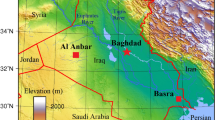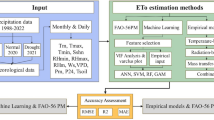Abstract
The transferability of random forest (RF) and support vector machine (SVM) for estimating daily global solar radiation using long-term data of measured sunshine duration, extraterrestrial solar radiation, and theoretical sunshine duration was evaluated across different climate zones. Root mean square error (RMSE), Pearson correlation coefficient (R), and Lin’s concordance correlation coefficient (LCCC) were applied to evaluate model transferability performance. Generally, RF and SVM gave better transfer performance in the climate zone where they were developed. On average, RF (RMSE = 0.881 kWh/m2, R = 0.918, LCCC = 0.885) performed better than SVM (RMSE = 0.93 kWh/m2, R = 0.913, LCCC = 0.87) over the study area. RF had narrow ranges of RMSE, R, and LCCC, indicating that RF was more stable for transfer. The transferability performance of RF was mainly affected by the difference in elevation between source and target sites, and SVM was mostly controlled by the distance and difference in elevation between source and target sites. The results indicated that RF might be applied to estimate daily global solar radiation using sunshine duration at the sites within 500 km distance and 1000 m difference in elevation, and SVM within 500 km distance and 500 m difference in elevation between source and target sites.




Similar content being viewed by others
Data availability
Data are available with the corresponding author.
Code availability
Not applicable.
Abbreviations
- A:
-
Equatorial climate zone
- ANFIS:
-
Adaptive neuro-fuzzy inference system
- ANN:
-
Artificial neural network
- B:
-
Arid climate zone
- C:
-
Warm temperature climate zone
- Ds:
-
Distance between source and target sites
- D:
-
Snow climate zone
- dElevation:
-
Difference in elevation between source and target sites
- dN:
-
Difference in sunshine duration between source and target sites
- E:
-
Polar climate zone
- LCCC:
-
Lin’s concordance correlation coefficient
- MDA:
-
Mean decrease in accuracy
- MDG:
-
Mean decrease in Gini
- MLP:
-
Multi-layer perceptron
- MLR:
-
Multiple linear regression
- mtry:
-
Number of variables used at each split
- N:
-
Sunshine duration
- No:
-
Theoretical sunshine duration
- ntree:
-
Number of trees for random forest
- R :
-
Pearson correlation coefficient
- RBF:
-
Radial basis function
- RF:
-
Random forest
- RMSE:
-
Root mean square error
- Ro:
-
Extraterrestrial solar radiation
- Rs:
-
Global solar radiation
- SVM:
-
Support vector machine
- Szone:
-
Zone where models are trained
- Tzone:
-
Zone where models are tested
References
Ångstrom A (1924) Solar and terrestrial radiation. Q J Roy Meteor Soc 50:121–125
Allen RG, Pereira LS, Raes D, Smith M (1998) Crop evapotranspiration-guidelines for computing crop water requirement. Irrigation and drainage paper 56, Food and Agriculture Organization of the United Nations (FAO): Rome, Italy
Amit Y, Geman D (1997) Shape quantization and recognition with randomized trees. Neural Comput 9:1545–1588
Benali L, Notton G, Fouilloy A, Voyant C, Dizene R (2019) Solar radiation forecasting using artificial neural network and random forest methods: application to normal beam, horizontal diffuse and global components. Renew Energ 132:871–884
Besharat F, Dehghan AA, Faghih AR (2013) Empirical models for estimating global solar radiation: a review and case study. Renew Sustain Energ Rev 21:798–821
Breiman L (1996) Bagging predictors. Mach Learn 26:123–140
Breiman L (2001) Random forests. Mach Learn 45:5–32
Bristow KL, Campbell GS (1984) On the relationship between incoming solar radiation and daily maximum and minimum temperature. Agric for Meteorol 31(2):159–166
Chen JL, Liu HB, Wu W, Xie DT (2011) Estimation of monthly solar radiation from measured temperatures using support vector machines-a case study. Renew Energ 36:413–420
Chen JL, Li GS, Xiao BB, Wen ZF, Lv MQ, Chen CD, Jiang Y, Wang XX, Wu SJ (2015) Assessing the transferability of support vector machine model for estimation of global solar radiation from air temperature. Energ Convers Manage 89:318–329
Chen JL, Li GS, Wu SJ (2013) Assessing the potential of support vector machine for estimating daily solar radiation using sunshine duration. Energ Convers Manage 75:311–318
Cristianini N, Shawe-Taylor J (2000) An introduction to support vector methods. Cambridge Univ. Press, Cambridge
De Felice M, Petitta M, Ruti PM (2015) Short-term predictability of photovoltaic production over Italy. Renew Energ 80:197–204
De Souza JL, Nicácio RM, Moura MAL (2005) Global solar radiation measurements in Maceió. Brazil Renew Energ 30(8):1203–1220
El-Metwally M (2004) Simple new methods to estimate global solar radiation based on meteorological data in Egypt. Atmos Res 69(3–4):217–239
El-Metwally M (2005) Sunshine and global solar radiation estimation at different sites in Egypt. J Atmos Sol-Terr Phy 67:1331–1342
Ertekin C, Yaldiz O (2000) Comparison of some existing models for estimating global solar radiation for Antalya (Turkey). Energ Convers Manage 41:311–330
Fan J, Wang X, Wu L, Zhou H, Zhang F, Yu X, Lu X, Xiang Y (2018) Comparison of support vector machine and extreme gradient Boosting for predicting daily global solar radiation using temperature and precipitation in humid subtropical climates: a case study in China. Energ Convers Manage 164:102–111
Fan J, Wu L, Zhang F, Cai H, Zeng W, Wang X, Zou H (2019) Empirical and machine learning models for predicting daily global solar radiation from sunshine duration: a review and case study in China. Renew Sust Energ Rev 100:186–212
Flake G, Lawrence S (2002) Efficient SVM regression training with SMO. Mach Learn 46:271–290
Fouilloy A, Voyant C, Notton G, Motte F, Paoli C, Nivet M, Guillot E, Duchaud J (2018) Solar irradiation prediction with machine learning: forecasting models selection method depending on weather variability. Energ 165:620–629
Gala Y, Fernández Á, Díaz J, Dorronsoro JR (2016) Hybrid machine learning forecasting of solar radiation values. Neurocomputing 176:48–59
Hargreaves GH, Samani ZA (1982) Estimating potential evapotranspiration. J Irrigat Drain Div 108(3):225–230
Hassan MA, Khalil A, Kaseb S, Kassem MA (2017) Exploring the potential of tree-based ensemble methods in solar radiation modeling. Appl Energ 203:897–916
Hawila D, Mondal MAH, Kennedy S, Mezher T (2014) Renewable energy readiness assessment for North African countries. Renew Sustain Energ Rev 33:128–140
Ho TK (1995) Random decision forest. Proceedings of the 3rd international conference on Document Analysis and Recognition. 278–282
Ho TK (1998) The random subspace method for constructing decision forests. IEEE t Pattern Anal 20(8):832–844
Huang J, Troccoli A, Coppin P (2014) An analytical comparison of four approaches to modelling the daily variability of solar irradiance using meteorological records. Renew Energ 72:195–202
Hunt LA, Kuchar CJ (1998) Swanton. Estimation of solar radiation for use in crop modelling. Agric for Meteorol 91:293–300
Ibrahim IA, Khatib T (2017) A novel hybrid model for hourly global solar radiation prediction using random forests technique and firefly algorithm. Energ Convers Manage 138:413–425
Kim S, Seo Y, Rezaie-Balf M, Kisi O, Ghorbani M, Singh V (2019) Evaluation of daily solar radiation flux using soft computing approaches based on different meteorological information: peninsula vs continent. Theor Appl Climatol 137:693–712
Kottek M, Grieser J, Beck C, Rudolf B, Rubel F (2006) World map of the Köppen-Geiger climate classification updated. Meteorol Z 15:259–263
Li MF, Liu HB, Guo PT, Wu W (2010) Estimation of daily solar radiation from routinely observed meteorological data in Chongqing. China Energ Convers Manage 51(12):2575–2579
Li MF, Tang XP, Wu W, Liu HB (2013) General models for estimating daily global solar radiation for different solar radiation zones in mainland China. Energ Convers Manage 70:139–148
Liu X, Mei X, Li Y, Wang Q, Jensen JR, Zhang Y, Porter JR (2009) Evaluation of temperature-based global solar radiation models in China. Agric for Meteorol 149:1433–1446
Liu DL, Scott BJ (2001) Estimation of solar radiation in Australia from rainfall and temperature observations. Agric for Meteorol 106:41–59
Long H, Zhang Z, Su Y (2014) Analysis of daily solar power prediction with data driven approaches. Appl Energ 126:29–37
Mahmood R, Hubbard KG (2002) Effect of time and temperature observation and estimation of daily solar irradiance for the northern Great Plains. USA Agron J 94:723–733
Molina A, Falvey M, Rondanelli R (2017) A solar radiation database for Chile. Sci Rep 7:14823
Quej VH, Almorox J, Ibrakhimov M, Saito L (2017) Estimating daily global solar radiation by day of the year in six cities located in Yucatan Peninsula Mexico. J Clean Prod 141:75–82
Prescott J (1940) Evaporation from a water surface in relation to solar radiation. Trans Roy Soc s Aust 64(1):114–118
Rensheng C, Shihua L, Ersi K, Jianping Y, Xibin J (2006) Estimating daily global radiation using two types of revised models in China. Energ Convers Manage 47:865–878
Rossel RAV et al (2016) A global spectral library to characterize the world’s soil. Earth-Sci Rev 155:198–230
Salcedo-Sanz S, Deo RC, Cornejo-Bueno L et al (2018) An efficient neuro-evolutionary hybrid modelling mechanism for the estimation of daily global solar radiation in the Sunshine State of Australia. Appl Energ 209:79–94
Samadianfard S, Majnooni-Heris A, Qasem S, Kisi O, Shamshirband S, Chau K (2019) Daily global solar radiation modeling using data-driven techniques and empirical equations in a semi-arid climate. Eng Appl Comp Fluid 13:142–157
Samanta S, Patra PK, Banerjee S, Narsimhaiah L, Chandran MAS, Kumar PV, Bandyopadhyay S (2019) Generation of common coefficients to estimate global solar radiation over different locations of India. Theor Appl Climatol 136:943–953
Sun H, Gui D, Yan B, Liu Y, Liao W, Zhu Y, Lu C, Zhao N (2016) Assessing the potential of random forest method for estimating solar radiation using air pollution index. Energ Convers Manage 119:121–129
Thornton PE, Running SW (1999) An improved algorithm for estimating daily solar radiation from measurements of temperature, humidity, and precipitation. Agric for Meteorol 93:211–228
Torres-Barrán A, Alonso Á, Dorronsoro JR (2019) Regression tree ensembles for wind energy and solar radiation prediction. Neurocomputing 326–327:151–160
Trnka M, Zalud Z, Eitzinger J, Dubrovský M (2005) Global solar radiation in Central European lowlands estimated by various empirical formulae. Agric for Meteorol 131:54–76
Urraca R, Martinez-de-Pison E, Antonanzas J, Antonanzas-Torres F (2017) Estimation methods for global solar radiation: case study evaluation of five different approaches in central Spain. Renew Sustain Energ Rev 77:1098–1113
Vapnik VN (1995) The nature of statistical learning theory. John John Wiley & Sons, New York
Wang L, Kisi O, Zounemat-Kermani M, Zhu Z, Gong W, Niu Z, Liu H, Liu Z (2017) Prediction of solar radiation in China using different adaptive neuro-fuzzy methods and M5 model tree. Int J Climatol 37:1141–1155
Winslow JC, Hunt JR, Piper SC (2001) A globally applicable model of daily solar irradiance estimated from air temperature and precipitation data. Ecol Model 143:227–243
Wu W, Liu HB (2012) Assessment of monthly solar radiation estimates using support vector machines and air temperatures. Int J Climatol 32:274–285
Yorukoglu M, Celik AN (2006) A critical review on the estimation of daily global solar radiation from sunshine duration. Energ Convers Manage 47(15):2441–2450
Zhao N, Zeng X, Han S (2013) Solar radiation estimation using sunshine hour and air pollution index in China. Energ Convers Manage 76:846–851
Acknowledgements
We would like to thank the National Meteorological Information Center of China Meteorological Administration for providing the meteorological data.
Author information
Authors and Affiliations
Contributions
Methodology: Wei Wu and Mao-Fen Li; resources: Xiao-Ping Tang, Mao-Fen Li, and Hong-Bin Liu; supervision: Hong-Bin Liu; writing: Wei Wu, Mao-Fen Li, Xia Xu, Xiao-Ping Tang, Chao Yang, and Hong-Bin Liu.
Corresponding author
Ethics declarations
Ethics approval
This study did not involve any protected area, private land, and endangered or protected species. And no specific permissions were required for these activity.
Consent to participate
Not applicable.
Consent for publication
Written informed consent for publication was obtained from all authors.
Conflict of interest
The authors declare no competing interests.
Additional information
Publisher’s note
Springer Nature remains neutral with regard to jurisdictional claims in published maps and institutional affiliations.
Rights and permissions
About this article
Cite this article
Wu, W., Li, MF., Xu, X. et al. The transferability of random forest and support vector machine for estimating daily global solar radiation using sunshine duration over different climate zones. Theor Appl Climatol 146, 45–55 (2021). https://doi.org/10.1007/s00704-021-03726-6
Received:
Accepted:
Published:
Issue Date:
DOI: https://doi.org/10.1007/s00704-021-03726-6




